Skyautomach is a professional machinery manufacturer of air bubble film.
Skyautomach was founded in 2005, but we have a group of experts that has twenty years of experience in this fieid. To achieve customer satisfaction, we provide a customized solution by carrying out extensive research in our pilot plants, on the raw material and the ultimate product till a solution is found. Based on the research we provide a turn-key project including training in operations and management.
Skyautomach was founded with two fundamental goals. (1) To provide the best possible experience to every one of our customers. (2) To provide customers with the most competitive prices and reliable quality. We are continually striving to validate the trust you place in our company.
From Owners to Operators, our sales and managements teams are dedicated to understanding your business, delivering and exceeding all your expectations. We believe that the key to our success is our commitment to your success. We look forward to a company that make success.
Let your success start from here.
Address:No.38 Jianhu Road,Taicang,Jiangsu,China TEL:86-512-53415118 FAX:86-512-53414728
E-Mail: marketing@skyautomach.com marketing@skypoolcover.com
bubble wrap maker moving to N. Carolina – After 54 years in northern New Jersey, Sealed Air Corp. – the maker of Bubble Wrap – said on Wednesday it is moving its corporate headquarters and 200 jobs to Charlotte, North Carolina, where it will receive up to $36 million in tax breaks from the state.
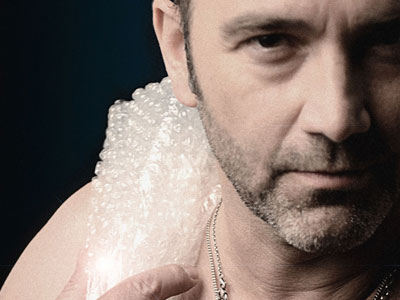
It is the latest in a string of corporate departures from northern New Jersey, as states compete for jobs in a tight employment market.
While Sealed Air will move the 200 high-paying jobs from New Jersey, about 100 jobs will remain at Sealed Air’s manufacturing plant in Saddle Brook, New Jersey, spokesman Ken Aurichio said.
Besides the corporate executives, jobs to be moved include positions in finance, sales and marketing, human resources and research and development.
A spokeswoman for the New Jersey Economic Development Authority said the company did not approach the state before deciding to move out.
“We are disappointed to hear that Sealed Air has decided to relocate their operations to North Carolina,” spokeswoman Erin Gold said. “However, as they never came to us to discuss incentives, we had no opportunity to compete for (the headquarters) to stay. We are happy to see that manufacturing is staying.”
The move will send a total of 1,262 jobs, with an average salary of $119,482, to Charlotte in a new $50 million headquarters as Sealed Air consolidates three divisions, research and development and corporate offices. The jobs will be moved over the next three years from Connecticut, Wisconsin and South Carolina, as well as New Jersey.
The Fortune 500 company, which also makes cleaning products, disinfectants and several types of packaging, employs about 25,000 people worldwide and had revenues of $7.7 billion last year.
“This move will contribute to a stronger, one-company culture that will enable greater collaboration, efficiencies, and better use of our investments in people and new technologies,” Jerome Peribere, chief executive of Sealed Air, said in a statement.
Aurichio said the company considered five states for the consolidation but declined to say whether New Jersey had been in the running.
The Sealed Air announcement follows the recent departures from northern New Jersey of other large corporations, including Hertz, which left for Estero, Florida, last year, taking 550 jobs. Hertz got $85 million in tax breaks from Florida.
In addition, Roche is shutting its 119-acre New Jersey campus, which housed 2,000 workers as recently as 2012.
Overall, at least a dozen companies since 2007 have announced plans to leave the area, including Quest Diagnostics, Barr Pharmaceuticals, Ingersoll-Rand, Hunter Douglas, Bayer HealthCare Pharmaceuticals, Pearson Education and Ashland Specialty Ingredients.
However, there has also been corporate migration into the area. Haier America, a large appliance company, is planning to move its headquarters to Wayne from New York City this year.
James Hughes, a Rutgers economist, said the Sealed Air move is evidence of “an economic war between the states.”
He added: “There are critics of New Jersey providing tax incentives, but this provides pretty good evidence that New Jersey is being forced to play that game. We have competitors out there looking to steal our assets.”
Still, Hughes and fellow Rutgers economist Joseph Seneca said that the North Carolina incentives are not that large and are likely to have been only one factor in Sealed Air’s decision to move.
New Jersey has much higher land costs, a higher cost of living and higher taxes than North Carolina. New Jersey’s corporate income tax is 9 percent, and its top personal income tax rate is 8.97 percent. By contrast, North Carolina’s corporate tax rate is 6 percent, and its top income tax rate is 5.8 percent.
John Boyd Jr., a principal with the corporate relocation consultant Boyd Co. in Princeton, New Jersey, estimated that building a new headquarters would cost about 20 percent more in northern New Jersey than it would in North Carolina.
“There’s a lot of cost savings by making this move,” Hughes said. On the other hand, he said, New Jersey offers employers a high quality of life, good schools and an educated workforce.
Seneca said it was notable that Sealed Air is keeping some manufacturing in New Jersey, which has been losing factory jobs for decades.
Sealed Air was founded in 1960 in Hawthorne, New Jersey, after the inventors Marc Chavannes and Al Fielding tried to create a textured wallpaper. According to company lore, Chavannes looked out the window of a plane landing at Newark Airport and, spotting the puffy clouds, got the idea for protective packaging made of air bubbles trapped in plastic.
The company grew through the 1998 acquisition of the Cryovac line of packaging from W.R. Grace & Co. and the 2011 purchase of Diversey Holdings, a Wisconsin cleaning-products company.
Sealed Air posted profits of $72 million for the first quarter. The company will announce second-quarter results next Wednesday.
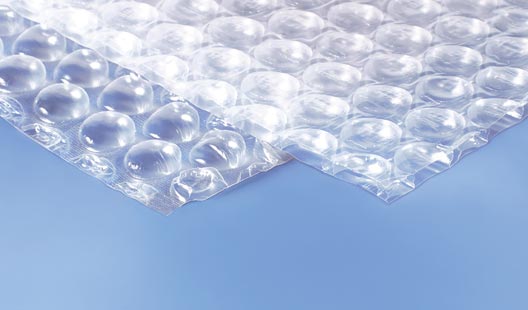
bubble wrap, a commonly used packaging material, also interests many of its addictive popping features. It’s a strange fun to pop those bubbles. However, primarily these wraps are used for ensuring the safety of the goods during shipping and posting. Bubble wraps are thin plastic sheets with small sealed air filled bubbles, which vary in size.
Sheets with small bubbles are used for the packaging of more fragile items like glass decorative products, glassware or electronic items. The large sized bubble wraps are used for packaging and protecting slightly robust products like furniture from getting scratched . Sometimes, these are also used for filling in the voids left out in packaging boxes so that the items can remain in one place and don’t break off during shipping, loading and unloading. In the market there are variety of bubbles wraps are available in different forms such as rolls, sheets and bags. Different forms or types suit different packaging requirement, such as :
- Large sized bubbles for packing slightly sturdy products
- Small sized bubbles for packing very fragile items.
- Anti-static Bubble wraps, for packaging static sensitive electronic products like computer parts.
- Self Adhesive wraps are used when a more secure packaging is required; these wraps don’t leave residue on the items
- As an environmental safety has become very important, so even biodegradable bubble wraps are available in the market.
- Bubble Wrap Bags are pouches that are used for carrying small items.
If you are in need of bubble wraps and looking for some reliable sources for purchasing these, then online buying can be a good option for you. It’s good if you know any local supplier from whom you can directly buy the product. But if you don’t have access to any such supplier then you can go for online purchasing . It’s very easy to do the online buying as you get doorstep delivery.
Rest, you get access to a large number of trusted suppliers and can select your product from an extended variety. Online suppliers also offer good discounts to make your deal more profiting.Hence, online purchasing is a good option for both looking for bulk or single roll purchasing. However, on placing bulk orders like 200 meters at once, you can even get your order at wholesale rates.
If you already posses some used bubble wraps, where the bubbles are not yet popped up, then consider re-using them as these can be re-used twice or thrice, and it’s also an environment safety measure.
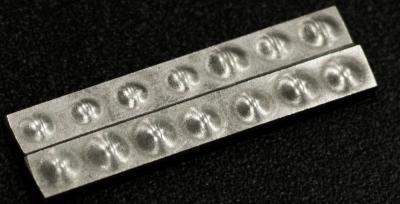
New metallic bubble wrap is far stronger than plastic bubble wrap, and more than 50 percent more bendable than flat sheet metal. This metallic bubble wrap was designed to be more durable than regular bubble wrap and other packing materials.
Engineers at North Carolina State University invented the metallic bubble wrap as a way to improve the durability of packaging materials for electronics and suitcases, along with other products such as car doors, airplane wings and helmets, where it can also be used in the products themselves. The metal is not meant to replace traditional plastic bubble wrap, but to be used when circumstances call for sturdier cushioning.
“If you are packing a piece of glass to ship it, you may still want to use plastic,” Afsaneh Rabiei, an engineer from NC State University and lead researcher on the project, told LiveScience. “But if you are packing yourself in a car, and want to protect against car injury, this could be used inside doors, the hood, really any part of the car.”
To create the material, the team pressed small depressions into thin sheets of aluminum using a studded roller. The engineers then filled the dimples with a foaming agent, covered the sheet with a flat layer of aluminum, and melded the two pieces of aluminum together with a heavy roller. Finally, they placed the merged sheets in a furnace, causing the foaming agent to decay and break down into air bubbles that became trapped within each dimple.
As the material bends, the bubbles deform and absorb energy, allowing the metal to bend more than it would without the bubbly cushion.
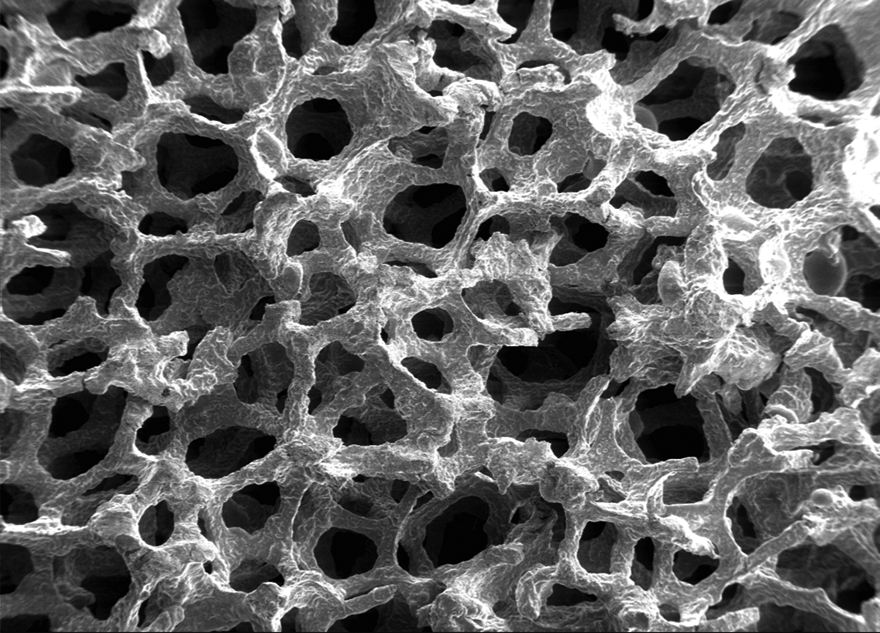
The team had to troubleshoot several times to figure out a way to make sure the foam did not shift before the layers were melded together, Rabiei said. This is a crucial step in the process because, if the foam leaks before the layers are secured together, air pockets develop in improper places and the material weakens.
Rabiei still has not tried to pop the bubble wrap between her fingers, but she doesn’t think it would work very well.
“It all depends on how thin of a sheet of metal you have, but I doubt it,” Rabiei said. “The point is that you are making it to be stronger than regular bubble wrap. Maybe if you bang on it with a hammer you may pop it, but I’ve never tried.”
Next, the team plans to experiment with different thicknesses and types of metals, hoping to replicate the design with steel and titanium.
The group presented their invention for the first time on June 24 at the 8th International Conference on Porous Metals and Metallic Foams in Raleigh, NC, and they are in the process of publishing their first scientific paper describing it. The project is not yet funded, and the team is waiting for funding before moving further in development.
NEW ORLEANS — Ever reacted to the sight of a cute puppy or darling infant by squealing, “I want to eat you up!”? Or maybe you can’t help but want to pinch your grandbaby’s adorable cheeks. You’re not alone. New research finds that seemingly strange aggressive responses to cuteness are actually the norm.
In fact, people not only verbalize these aggressive desires with phrases like, “I just want to squeeze something!” they also really do act them out. In the study, presented Friday (Jan. 18) here at the annual meeting of the Society for Personality and Social Psychology, researchers found that people watching a slideshow of adorable pictures popped more bubbles on a sheet of bubble wrap than did people viewing funny or neutral pictures.
“We think it’s about high positive-affect, an approach orientation and almost a sense of lost control,” said study researcher Rebecca Dyer, a graduate student in psychology at Yale University. “You know, you can’t stand it, you can’t handle it, that kind of thing.”
Too cute
Dyer got interested in what she and her colleagues call “cute aggression” after chatting with a fellow student about how adorable Internet pictures often produce the desire to squish or squeeze the cute critter. All the existing research on cuteness suggests the reaction should be the opposite, she told LiveScience. People should want to treat a cute thing with gentleness and care.
And indeed, Dyer said, it’s not as though people really want to hurt a basketful of kittens when they see the furballs tumbling all over one another.
“We don’t have a bunch of budding sociopaths in our studies that you have to worry about,” she said.
But something odd seemed to be going on. So Dyer and her co-author, fellow Yale graduate student Oriana Aragon, first ran an experiment to see if cuteness aggression was a real phenomenon. They recruited 109 participants online to look at pictures of cute, funny or neutral animals. A cute animal might be a fluffy puppy, while a funny animal could be a dog with its head out a car window, jowls flapping. A neutral animal might be an older dog with a serious expression.
The participants rated the pictures on cuteness and funniness, as well as on how much they felt the pictures made them lose control — for example, if they agreed with statements such as “I can’t handle it!” The participants also rated the extent to which the pictures made them “want to say something like ‘grr!'” and “want to squeeze something.”
Sure enough, the cuter the animal, the less control and more desire to “grrr” and squeeze something that people felt. Cute animals produced this feeling significantly more strongly than did funny animals. The funny critters in turn produced the feeling more strongly than did neutral animals, perhaps because the funny animals were perceived as cute, too, Dyer said.
Dealing with adorable
Still, those results could have merely identified a verbal expression for cuteness, rather than a real feeling. So Dyer and her colleagues asked 90 male and female volunteers to come into a psychology laboratory and view a slideshow of cute, funny and neutral animals.
Researchers told the participants that this was a study of motor activity and memory, and then gave the subjects sheets of bubble wrap. The participants were instructed to pop as many or as few bubbles as they wanted, just as long as they were doing something involving motion.
In fact, the researchers really wanted to know if people would respond to cute animals with an outward display of aggression, popping more bubbles, compared with people looking at neutral or funny animals.
That’s exactly what happened. The people watching a cute slideshow popped 120 bubbles, on average, compared with 80 for the funny slideshow and just a hair over 100 for the neutral one.
Dyer said she and her colleagues aren’t yet sure why cuteness seems to trigger expressions of aggression, even relatively harmless ones. It’s possible that seeing a wide-eyed baby or roly-poly pup triggers our drive to care for that creature, Dyer said. But since the animal is just a picture, and since even in real life we might not be able to care for the creature as much as we want, this urge may be frustrated, she said. That frustration could lead to aggression.
Alternatively, people could be trying so hard not to hurt the animal that they actually do so, much as a child wanting to care for a cat might squeeze it too tightly (and get scratched for the effort).
Or the reason might not be specific to cuteness, Dyer said. Many overwhelmingly positive emotions look negative, as when Miss America sobs while receiving her crown. Such high levels of positive emotion may overwhelm people.
“It might be that how we deal with high positive-emotion is to sort of give it a negative pitch somehow, Dyer said. “That sort of regulates, keeps us level and releases that energy.”
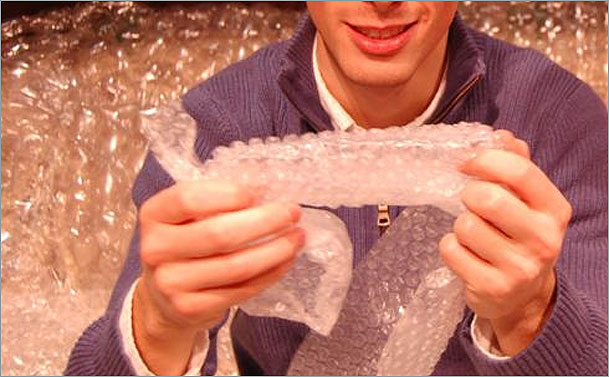
Posted by Jack Pickell
The pyramids, the Great Wall of China, Stonehenge… not today. This is the day we celebrate one of our weird world’s true wonders — that puffy, pop-able, pleasure-providing packing product known as bubble wrap.
Today, Jan. 28, 2013, is Bubble Wrap Appreciation Day (BWAD). Who says? The Bubble Wrap people do. They even have a site to prove it.
Bubble wrap has been around since about 1957, but somehow it didn’t have an annual day of recognition until 2001, when an Indiana radio station (finally) began the tradition.
Ask the person in the next cubicle his or her feelings about bubble wrap and you’re bound to get a nostalgic tale of jumping feet-first off the couch onto sheets of giant bubble wrap, or memories of popping the tiny bubbles from the sleeve that held their very first calculator back in the mid-1970s (okay, that’s what my co-worker heard when she asked me about it).
The point is, bubble wrap has touched all our lives, and now, thanks to this whole internet thing (which I have to say really seems to be taking off), you can even play with bubble wrap online. Here you can customize your virtual bubble wrap by size and color, then snap to your heart’s content — complete with realistic sound effects.
So happy BWAD to you all, and if you have time, sneak over to your office’s supply cabinet, grab a little bubble wrap, and give it a pop or twelve. It might make your day a little brighter… just like it did all those years ago.
Just one week after bubble wrap Appreciation Day, a Boston construction worker was saved from a gruesome fate when his 30-foot fall was broken by the stuff, a spokesman for the Boston Fire Department told WCVB.
Footage of the scene indicates the lifesaving “bubble wrap,” as the spokesman called it, was not the familiar poppable packing material, but an off-white material used to cover scaffolding at the building where the man was working Monday.
The 38-year-old, whose name has not been released, landed on a pile of the material on the ground.
The fall’s impact left him stuck in the bubble wrap, and firefighters had to cut him out. He was checked into a hospital for shoulder and back injuries.
Bubble wrap — in any form — does a lot of good for this world. Last week, high school students in New Jersey set a new Guinness World Record for most people simultaneously popping bubble wrap, and, in doing so, raised money for the Sandy Hook Elementary School fund in Newtown, Conn.
In December, an Italian artist set out to rid Milan of stress by creating “anti-stress” bubble wrap-popping stations at bus stops.
Some art, just like bubble wrap, just begs for you to reach out and touch. But what if the art was bubble wrap – could you control yourself?
That is the impulse Bradley Hart, a Canadian visual artist, seems to be triggering with his current bubble wrap art exhibition at gallery nine5 in New York City. Hart has created a series of landscape and portrait mosaics by injecting large swaths of bubble wrap with a mixture of latex and acrylic paint colors. Up close, the paintings look like multi-colored bubble wrap, albeit with each bubble hardened. But from afar, the works resemble pixilated prints of digital images.
“I’m doing a post-modern, pointillist painting – although I don’t like to classify my work as paintings themselves,” Hart said. Rather, he views his work like a sculptor, prioritizing materials and process over the image itself.
The centerpiece of Hart’s show is a 5x4ft rendering of a smiling Steve Jobs’ digital image. Hart said he chose to “inject” Jobs out of a personal affinity for the late Apple pioneer.
“From a business point-of-view, as a CEO, all that stuff, I thought he was a great guy, a great personality,” explained Hart. “I can harken back and say ‘well yes, one of my first computers was an Apple II Plus.”
After deciding on a subject to inject into the bubble wrap, Hart employs a secretive process of mapping the image with software he developed with a friend. He then assigns a color code to his paint syringes and maps the bubble wrap. Each bubble is assigned a number that corresponds with a paint syringe. Working from the bottom and moving up, Hart and a team of assistants then painstakingly inject each bubble from behind the canvas. He averages a rate of three bubbles a minute.
“From cradle to grave, a painting can take anywhere from 120 [hours], upwards to my biggest piece so far, which was Dam Square – Amsterdam, [which] was 310 hours.”
Hart is drawn to bubble wrap in order to re-imagine its contemporary usage while also restoring the material to its original purpose. According to Hart, who has researched the material, bubble wrap was originally invented in 1957 to be used as wall paper. “I think I’ve taken something genuinely nobody imagined could be art, and as an artist, flipped it on its head,” he said.
As for the seemingly invariable prospect of spectators attempting to pop the painted bubble wrap, Hart said they will be disappointed. “The paint is filled within the bubble, and it is dry.”
To learn more about Bradley Hart’s bubble wrap paintings, you can visit his online portfolio. His exhibit at gallery nine5, “What? Where? When? Why? How?”, runs until April 5th.
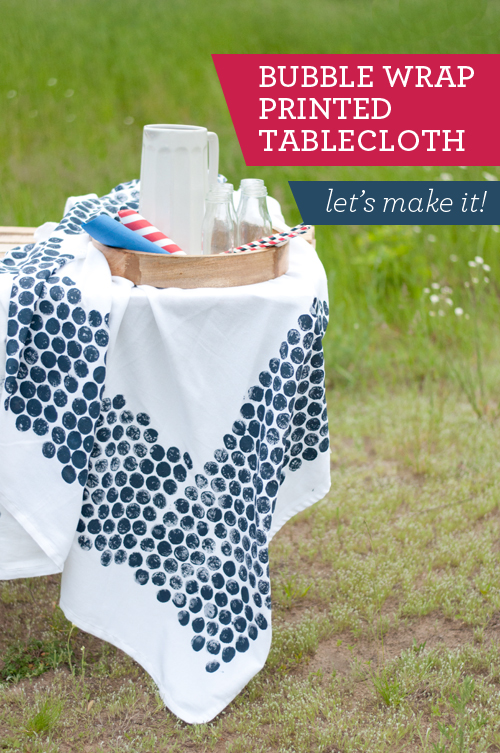
There is a reason tablecloths come in every color for every season — they add so much to a festive table setting! Have you seen this pin? I loved the idea of using something as utilitarian as bubble wrap to print with. And I thought a tablecloth — something I can use all summer long — was the perfect surface to try it out. Isn’t it fun to make art you can use?
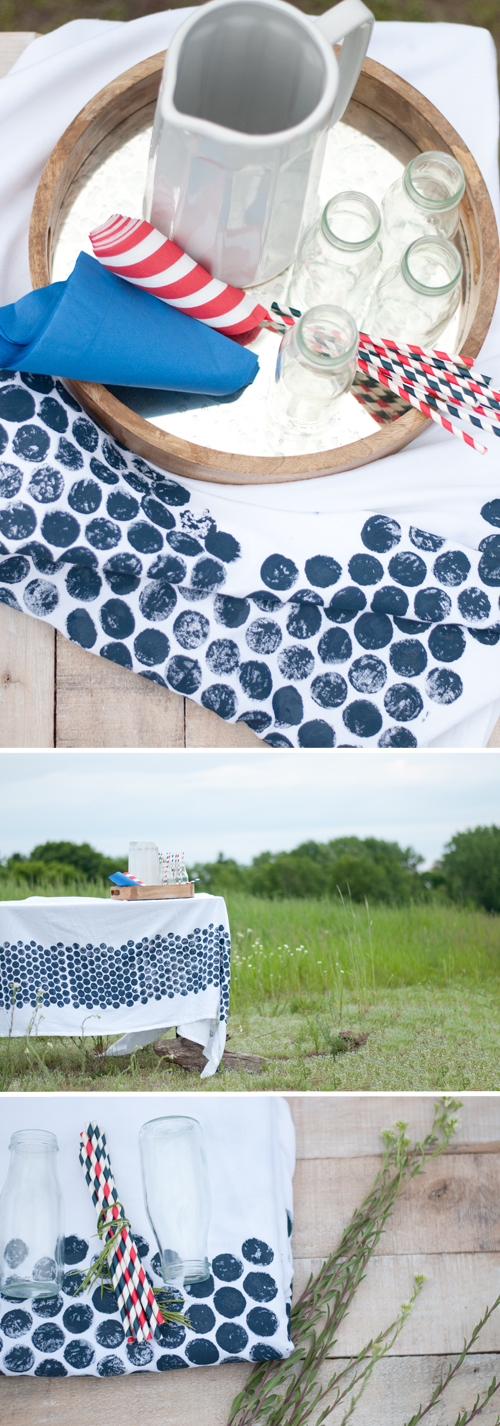
Printing with bubble wrap takes some patience and attention to detail. But don’t worry, I have tips below. And your fingers are sure to get a little painted as well, but the outcome is well worth the effort.
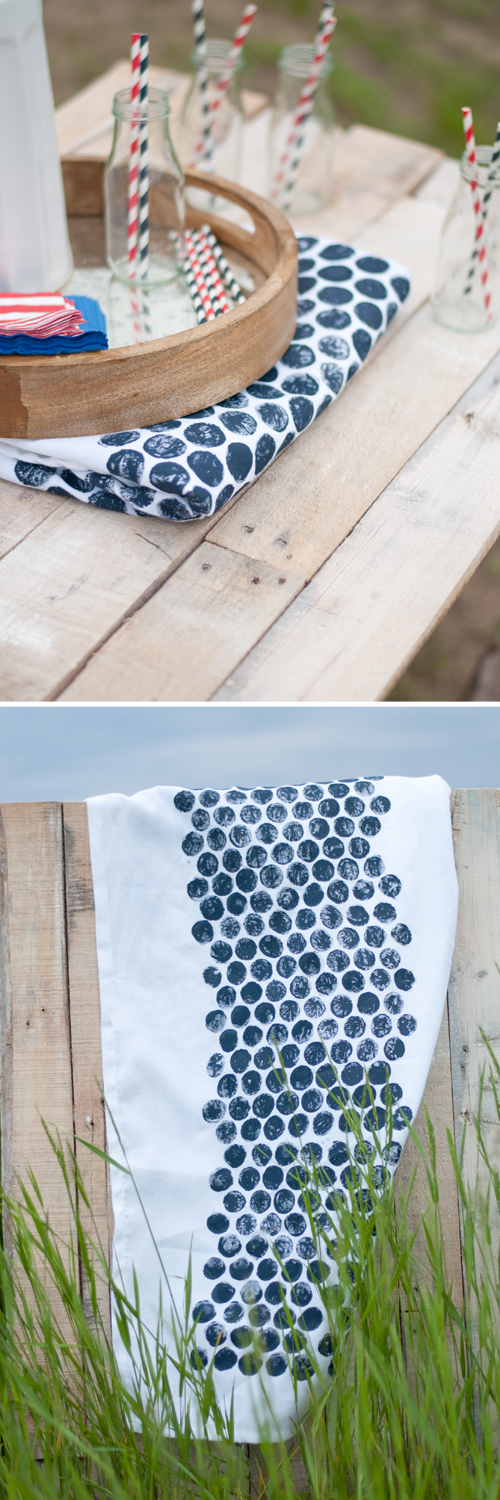
It’s a perfectly imperfect print. You can coordinate colors to your needs and you can use the same technique on a whole list of items — napkins, wrapping paper, the wall, clothing, pillows or lampshades, to name a few.
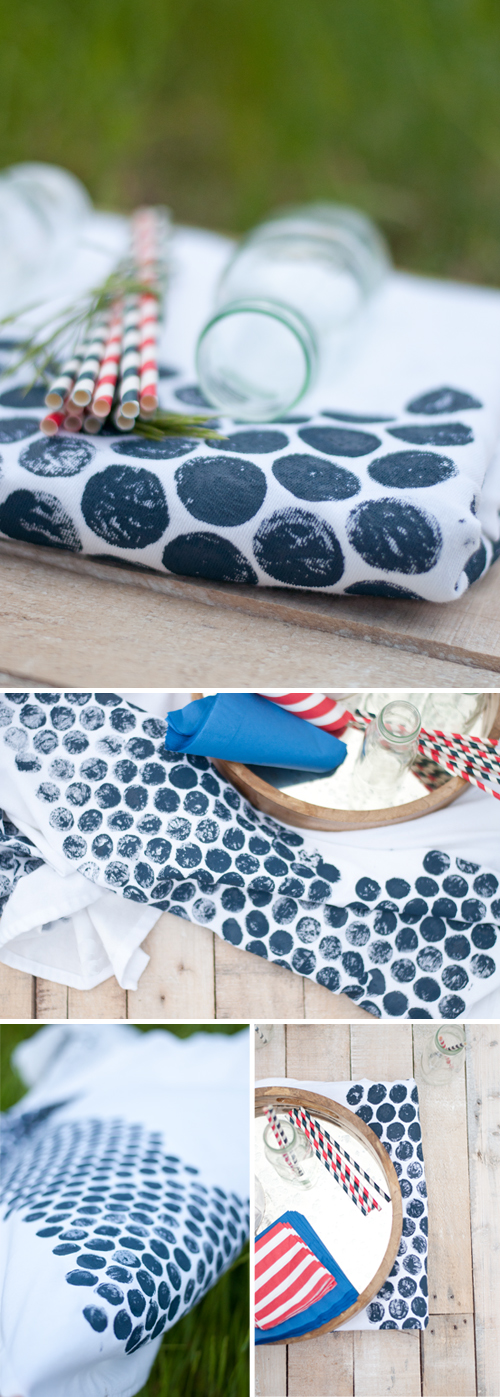
I think the hardest part of this particular project is saving an unpopped sheet from the happy bubble-popping feet of my little ones. : )
Let’s get to printing!
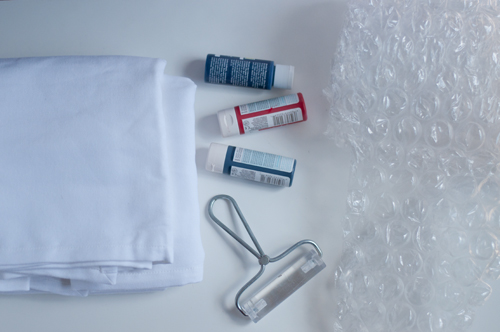
Supplies:
– tablecloth (I washed mine before hand because it was so wrinkly!)
– paint (I used between 7-8 craft paint bottles to do my tablecloth)
– brayer
– smooth, wipeable surface like plexi-glass or counter top or a disposable smooth surface like wax or parchment paper
– bubble wrap
– rag towel to wipe fingers
Decide how wide of a print you would like and cut the wrap accordingly. You can use and print with any length of bubble wrap strip, but a shorter piece is better. It’s rather unwieldy covered in paint!
Take time to cut away any deflated or halved bubbles because they can still hold paint and will make a messy print. Note: If you prep a strip of bubble wrap and then accidentally pop one like I did, the misprint can be fixed as I’ll explain below.
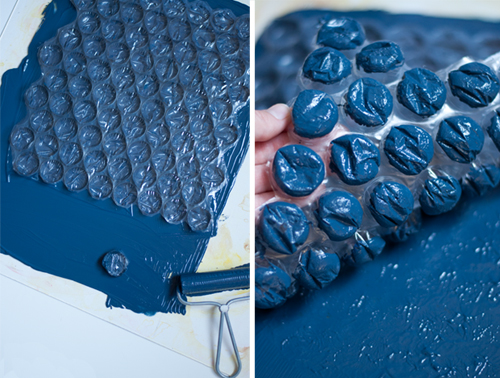
On your chosen smooth surface, add the paint. Use the brayer to smooth the paint onto a surface area large enough for your piece of bubble wrap.
A paint-loaded brayer or brush can be used to apply paint right to the bubble wrap, but, when printing on cloth, the paint color isn’t dense. The paint-on method does seem to work on paper.
Press the piece of bubble wrap into the paint, making sure all bubbles are adequately painted.

Carefully transfer the paint ladened bubble wrap to the tablecloth and press it down. When all parts of the bubble wrap have been pressed onto the tablecloth, gently pull it off.
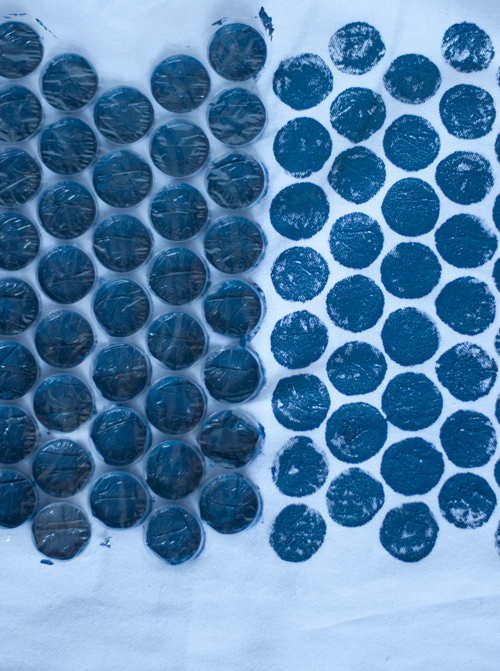
Repeat the print around the tablecloth, making note to line up the edges for each new print.
I found that the bubbles lined up differently depending on the angle so if you turn a corner, the outer edge might be different from one side to the next.
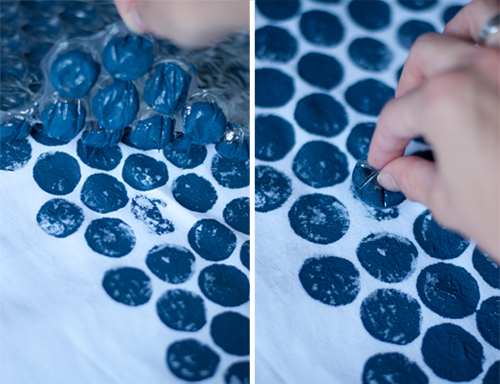
If there is a misprint or missing bubble, simply cut out one bubble and use it to correct the missing print.
One last note: I highly recommend you practice on paper first, just to get a feel for the printing process before you print the actual tablecloth.
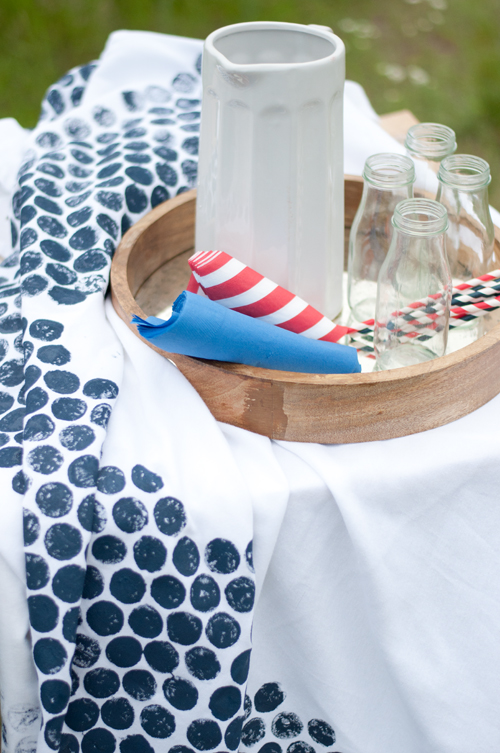
Allow to completely dry. Then get the tablewares, prep the meal, and enjoy!
Text and images by Amy Christie for Design Mom.
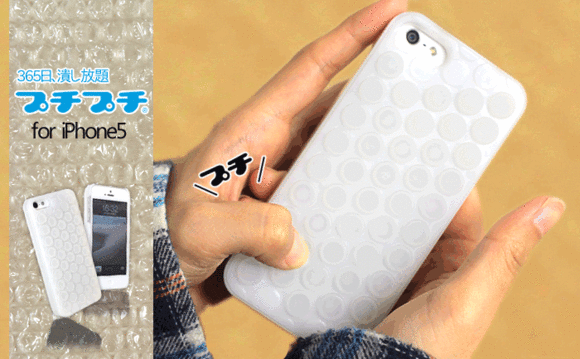
No, really. You’re reading that right. The Japanese did actually come up with a bubble wrap iPhone case. However, that’s not the incredible bit. What’s amazing is that it took so long for someone to capitalize on the world’s fondness for that ubiquitous layer of protection because, honestly, how could this have gone wrong?
Retailing for a not-quite-exorbitant 2100 yen (that’s $21USD) on Strapya, this iPhone 5 case is a definite improvement on the packaging that inspired it. Unlike actual bubble wrap, this iPhone 5 bubble wrap can be ‘popped’ till the arrival of the Flying Spaghetti Monster.
No more will you have to stare inconsolably at a flat piece of plastic after you’ve completely robbed it of its purpose in life. You can just keep on popping! Now, how is that for innovation? The case is composed of four layers: the actual casing, a squishy ‘bubble’ layer, push buttons and a ‘sound layer’ that emits that much-coveted noise.
Would you spend 21 bucks on something like this or would you rather purchase something of the edible variety to ensure you’ll never have to worry in case of a food shortage again? Let us know in the comments!
Paperboard cartons, brown paper, cardboard boxes, bubble wrap, moving boxes what you think that these all ar vital for? Is it safety of products or simple carriage, or for supplying associated sales? These all ar an integral a part of packaging that ar the outstanding art likewise as science of inclosure and protective, distribution, storage, selling and use of any variety of tangible sensible.
In fact is it thus intrinsic a part of our lives that we tend to don’t even understand after we acquire, use and dispose off the prepacked consumables and even store them in our charge. A use and thru drinkable is quickly consumed by you could be a results of a prepacked covering that holds that drink a branded covering that is noninheritable , detained and consumed and disposed in no time by US.
When you get a T.V. is safe jam-choked with cardboard material and bubble wrap and paper stuffed from within to safeguard it from any type of injury and making certain a straightforward transportation. this is often another variety of packaging that is geared toward safety, storage and handling of a heavy-delicate product.
Earliest recorded packaging dates back 1035 wherever expendable things like vegetables, spices and even the hardware were wrapped in papers at the purpose of sale.
However, this marked the start era of packaging and maintained a flow towards a lot of protecting, assured and complex styles of packaging with the growing wants of the users and diversifying utilities of product. With time packaging material became a lot of accommodating, functionally good and improved performance and incorporated advanced practices in providing packing, storage, labeling and provides.
This change entails the introduction of canned cans plated with steel for packaging of drinks within the nineteenth century. Even the paper board cartons and furrowed boxes replaced paper and jute wrapping within the later year for varied merchandise.
The world of packaging witnessed a paradigm shift once Bakelite closures, exhausting bind cardboard boxes, foam sheets, clear plastic wrap started being employed for inflated process potency and safety.
Today we tend to cannot assume even one product being transported, hold on or offered while not packaging. Water, pencils, computers, mirrors, clothes, medicines, phones, fruits, DTH, books, even cars ar packed after they ar transported to the showrooms.
Packaging isn’t simply inclosure a product or sensible everywhere at intervals associate opaque stuff or covering it altogether. Even simply a brown paper lying over prime of a chalkboard could be a variety of packaging in its own rights. Diced pork in receptacle are often overwrapped with a clear film which is another variety of packaging. somewhat pin in the midst of paper strap, or ribbon or a cork placed well all will the variants of packaging, most importantly once you remark brands and labeling. It conjointly includes customized formats together with some usually distinctive means of paper, designed covers, brand logo, water marked papers, communication Tubes and carrier luggage and cardboard marked with labels all forms a region of contemporary day packaging.
|
|















